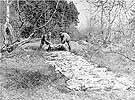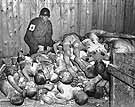
|
|
|

|

|

|

|
|
Click on an image to see a larger, more detailed picture.
|
|
|
|
|
| 1945: Liberation and Rebuilding |

|
pg. 603 |

|
|
|
|
| |
 The Allies often ordered the local population to exhume the bodies of prisoners killed in concentration camps or on death marches for proper burial, especially in cases such as this one in Helmbrechts, Germany, where female slave laborers from Eastern Europe had been buried in locations that were not well hidden.
The Allies often ordered the local population to exhume the bodies of prisoners killed in concentration camps or on death marches for proper burial, especially in cases such as this one in Helmbrechts, Germany, where female slave laborers from Eastern Europe had been buried in locations that were not well hidden.
Photo: National Archives/United States Holocaust Memorial Museum Photo Archive
|
 These recently rescued Jewish women had been slave laborers in a munitions factory in Kaunitz, Germany. The yellow crosses painted on their clothing had made them easily identifiable to the local German population, thereby decreasing the possibility of escape.
These recently rescued Jewish women had been slave laborers in a munitions factory in Kaunitz, Germany. The yellow crosses painted on their clothing had made them easily identifiable to the local German population, thereby decreasing the possibility of escape.
Photo: Hulton Getty Images
|
 Allies Interpret the Holocaust
Allies Interpret the Holocaust
The liberation of the concentration camps in Germany unleashed a torrent of information regarding the Nazis' treatment of the Jews. News reports focused on the mountains of corpses (including those pictured at Gotha, Germany), the horror and stench of the camps, and the surreal, skeletal figures who remained alive. Although news stories about the systematic mass murder of European Jewry had appeared in the Western media since 1942, virtually nobody had imagined the scenes that lurked behind the barbed-wire fences of Nazi camps. Reporting from Buchenwald, CBS radio correspondent Edward R. Murrow offered the following description: "There surged around me an evil-smelling stink. Men and boys reached out to touch me. They were in rags and the remnants of uniforms. Death already had marked many of them, but they were smiling with their eyes....Murder had been done at Buchenwald. God alone knows how many men and boys died there during the last 12 years." Well-intentioned reports such as this led people to mistakenly believe that the genocidal programs of the Nazis had taken place in Germany only. Many years elapsed before the full details of the "Final Solution" were pieced together and people were able to more accurately interpret the events of the Holocaust.
Photo: UPI / Corbis-Bettmann
|
|

|

|

|

|
 April 9, 1945: The concentration camp at Dora-Mittelbau, Germany, is liberated by the U.S. Army. Very few inmates remain alive.
April 9, 1945: The concentration camp at Dora-Mittelbau, Germany, is liberated by the U.S. Army. Very few inmates remain alive.
|
 April 10, 1945: SS functionary Adolf Eichmann visits the Theresienstadt, Czechoslovakia, camp/ghetto to gloat over the many Jews who have perished there.
April 10, 1945: SS functionary Adolf Eichmann visits the Theresienstadt, Czechoslovakia, camp/ghetto to gloat over the many Jews who have perished there.
|
 April 11, 1945: American troops liberate the concentration camp at Buchenwald, Germany; 21,000 inmates are still alive. In the Pathology Block (Block 2), GIs discover tanned and tattooed human skin.
April 11, 1945: American troops liberate the concentration camp at Buchenwald, Germany; 21,000 inmates are still alive. In the Pathology Block (Block 2), GIs discover tanned and tattooed human skin.
|
 April 11, 1945: The U.S. Infantry and 3rd Armored divisions liberate the concentration/slave-labor camp at Nordhausen, Germany.
April 11, 1945: The U.S. Infantry and 3rd Armored divisions liberate the concentration/slave-labor camp at Nordhausen, Germany.
|
 April 11, 1945: Inmates at the Aschersleben, Germany, camp are evacuated by the SS to Theresienstadt, Czechoslovakia.
April 11, 1945: Inmates at the Aschersleben, Germany, camp are evacuated by the SS to Theresienstadt, Czechoslovakia.
|
 April 12, 1945: U.S. Generals Dwight Eisenhower, George Patton, and Omar Bradley visit the camp at Ohrdruf, Germany, and view corpses and other evidence of Nazi atrocities.
April 12, 1945: U.S. Generals Dwight Eisenhower, George Patton, and Omar Bradley visit the camp at Ohrdruf, Germany, and view corpses and other evidence of Nazi atrocities.
|
|
|
|
|
| 1945: Liberation and Rebuilding |

|
pg. 603 |

|
|
The Holocaust Chronicle
© 2009 Publications International, Ltd.
|
|
